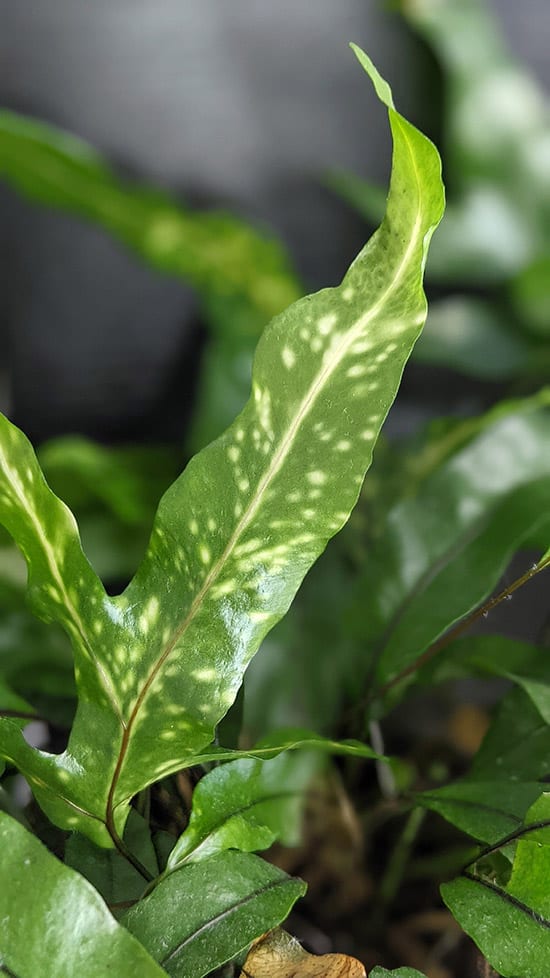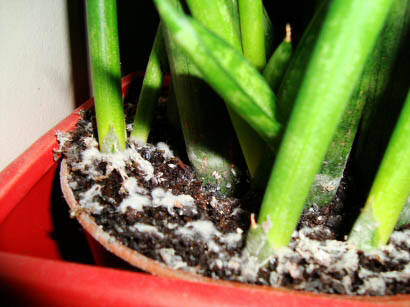Healthy indoor plants will be able to resist and fight off pests and diseases much better than weak plants.
In order to keep your houseplants strong you need to meet their cultural requirements, which involves using proper soil, avoiding drafts, not crowding plants and then keeping a good balance of temperature, humidity, light, water and drainage.

This houseplant has signs of a virus.
All plants have different requirements and if you aren't sure what these are, be sure to check out our Plant Hub to find out what balance and care your particular plant needs to thrive.
Chances are though you are on this page because prevention is too late and you have been afflicted with something nasty and want a treatment and you want it now! Trust us when we say, we feel your frustration. All is not lost however and the rest of this article offers some solutions.
The eight most common diseases that afflict houseplants are listed below along with the identifying symptoms and a suggested treatment. If you're having problems with something different or struggling with the identification, then let us know in the comments and we'll try and help you out.
Sometimes your plant will have a pest problem rather than a disease in which case you will need to head on over to our pest guide .
This is caused by fungal mycelia which lives in most soils. It normally lives peacefully with the houseplant, however when conditions become very damp through overwatering, cool conditions or poor ventilation it rapidly multiplies and infects the plant.
Black or discolored rotten patches at the base of the plant. It normally effects the base because this is the closest part to the soil and therefore the fungus, although it's possible other parts will be infected instead. Succulents and cacti are most at risk.
The only treatment is to cut out the rot and dust with an anti fungicide such as sulphur.
If the base has been very badly affected there is very little you can do because obviously if you're having to cut out whole lower sections of the plant you don't have a plant. It's therefore worth taking stem cuttings from the healthy upper parts and trying to propagate replacements.
Further reading -
What does root rot look like (and how to fix it)?

Hi, I'm Tom!
If you're like me and enjoy the challenge of growing houseplants and getting them to thrive, then Ourhouseplants can help. This website shares my knowledge and years of growing plants and provides (hopefully) helpful advice on properly caring for your indoor plant friends.
Gray Mold or Grey Mould is caused by airborne fungal that lands on damaged or dying tissue. Small wounds are normal on plants, if it's healthy and the conditions are reasonably dry it shouldn't be a problem. The issue arises when the plant is weak anyway and the surrounding atmosphere is humid and cool.

Botrytis isn't overly common, but it can easily take hold in humid growing spaces - Photo by Rasbak
Soft rotting patches which are soon covered in a grey fungus. There will more than likely be died brown patches on the leaves or stems, white or pale brown spots on flower petals or rotting on bulbs etc.
Remove the infected parts of the plant. Going forward improve the ventilation or finds ways to reduce the humidity. If the Mold has got out of hand you may have to throw it away completely.
"What's the white mold growing in my houseplant's soil"? Is one of our frequently asked questions. It's another fungus that quickly colonise the soil surface when conditions are moist, humid and over watered.
Ventilation is also typically poor therefore it tends to appear more in cooler months of the year when everything in the home is shut up tight. Don't worry though, as white mold is easily dealt with and basically harmless to plants and people.

While Mold on the soil surface is very common over winter, when temperatures are cooler and the soil takes longer to dry out.
The surface of the soil is coated in a white fluffy substance that looks like cotton wool.
No need to reach for the sprays here. All you need do is gently rake up the effected soil using something like the end of a pencil or pen. You don't need to pick it out or anything like that so it's a very easy job. The raking could free up the fungal spores into the air though so do be careful not to inhale them as they may potentially trigger allergies and aggravate asthma.
After delivering the treatment think about moving your plant to a more ventilated space or try and free the growing medium by making it more "open".
If you've never fed or repotted your plant then a nutrient deficiency is quite probable. The majority of plants make their own food through photosynthesis, however small levels of nutrients are needed to sustain that new growth and to ensure a healthy look.

Yellow leaves on a otherwise healthy plant can be an indication of a nutrient deficiency.
The nutrients are found in the soil but once they're gone they're gone and therefore it's important nutrients are replaced either by a fertiliser or by changing the soil occasionally.
There are many symptoms of nutrient deficiency in houseplants, although as a general rule you'll be experiencing unusual or poor growth.
The leaves may be very small with odd shapes, the colour of the plant may be dull or transparent in places. No flowers or flowers which are discolored or aborted before they can open can all be symptoms.
The immediate treatment for your plant is to either fertilise using an all purpose mixture or to repot using fresh compost. Choose only one to start with, rather than both at the same time as this could result in too much fertiliser which can damage the plant further. The rule of thumb is to wait at least 8 weeks before you start fertilising newly repotted plants.
Fortunately powdery mildew is often disfiguring rather than fatal. Nor is it overly common on indoor houseplants because it's caused by fungi spores that travel through the wind.

Not overly common on indoor plants, but some like Gerbera's can still be susceptible.
Obviously if you've been summering your houseplants outdoors then you increase your risk. Warm, damp locations and plants which are situated very close together all increase your chances of the fungi taking hold and spreading.
A white film which looks like a light dusting of flour coats the leaves, over time the white look may dull and become darker. If left unchecked it will spread over the entire plant, including the stems and flowers.
Remove the badly infected mildewed leaves with care (you don't want to be acting like an artificial wind by blowing the spores around other plants). Then spray with a product containing Myclobutanil, Penconazole, Flutriafol or lightly dust the leaves with Sulphur to give control.
If you want to try a more organic and less synthetic approach, look into making a homemade Neem Oil spray.
Rust is a common disease on Roses outdoors but inside, it's rather rare.
If you grow Roses, Chrysanthemums, Pelargoniums or Fuchsias as houseplants you will need to watch out for infection as eradication is very difficult. Therefore if Rust is suspected you must isolate it from other houseplants to prevent it spreading.

Fortunately, rust is another rare problem for indoor plants. Photo by CSIRO
Brown rings or spots on the leaves. They usually start on the underside although in more advanced stages they can appear on either side. Leaves may fall prematurely without any yellowing before hand and often when you gently brush past.
Normally complete eradication of Rust is difficult and you may only be able to control it. In any event you should carefully remove the infected leaves and try not to shake or knock the Rust spores from the discs as this will just spread the infection to other parts of the same plant or close neighbors.
If this doesn't work, any chemical product containing Mancozeb, Penconazole or Flutriafol should help. Neem Oil can also have good results if you have some to hand.
This is a disease which has a very visible presence. It's not actually hurting the plant in the first instance but rather on the honeydew that is produced as a waste product by several pests, such as Scale.

The Umbrella Plant is very attractive to Scale so is prone to Sooty Mold - Photo by Amnon Shavit.
The honeydew is a clear substance but at certain visual angles you can see it as a sticky looking residual.
As soon as the room becomes humid and less ventilated, perhaps as Winter approaches and we close our windows and switch on the central heating, the fungus takes hold and all the previously clear residual turns greeny black and moldy.
Black or dark green soot like spots. In extreme cases it will coat entire leaves as in the photo above.
Sooty Mold does not directly harm the plant however it's horrible and unpleasant to look at. You can remove it by wiping over the leaves with a damp cloth. Afterwards rinse the leaves with clean water. Ensure you eradicate the pest problem at the same time to prevent it returning.
Viruses are a broad topic, the symptoms are varied and most types of plant are effected from time to time. They're typically spread by long term pests such as Aphids or by the plant being in close proximity to one that has already been effected with a virus.

There is no cure for most plant viruses, but some houseplants can co-exist with them for many years.
There are many symptoms of a plant virus and they can appear differently depending what type of houseplant has been infected.
Growth may be stunted, twisted or distorted. Leaves may be yellowed or mottled in spots, mosaics or streaks. Any flowers may become streaked or not develop correctly i.e. they may mature and open but still be a green colour when they should be something else.
There is no cure. If the symptoms can't be tolerated then you will need to throw it away. Don't try to propagate any part of the plant because there is a high possibility the virus will remain and prosper in the new plants.